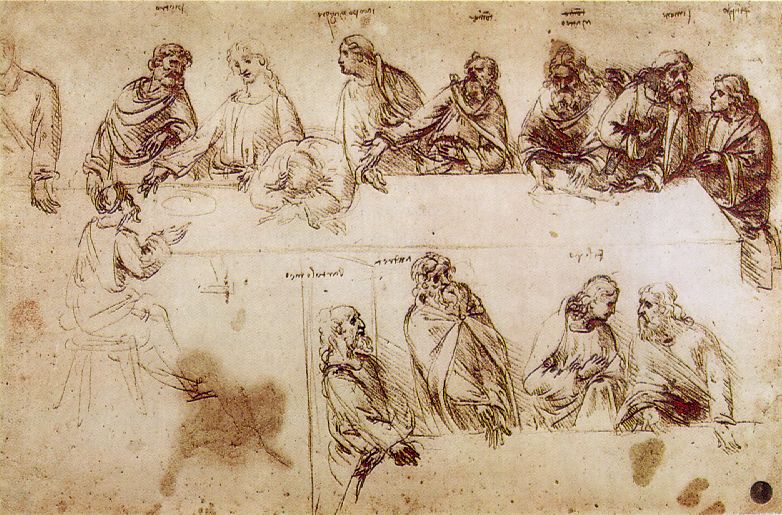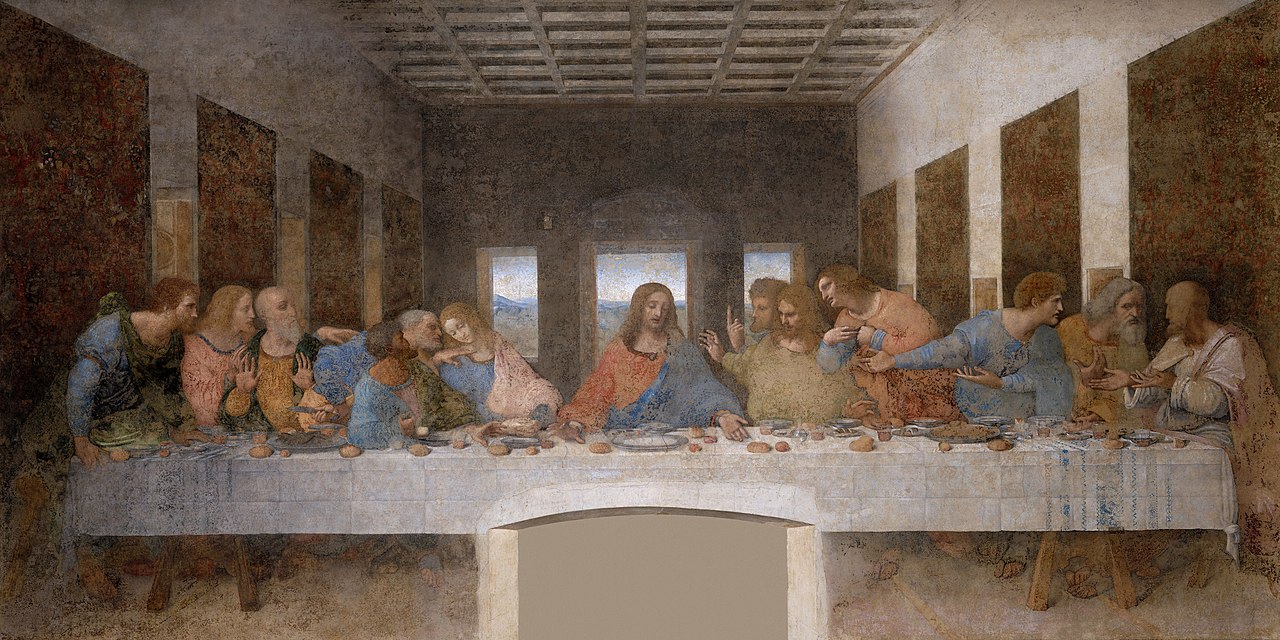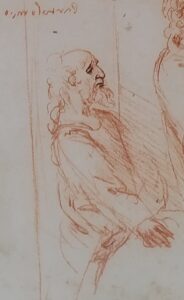As I consider the preparatory study as throughout gathering of information, together with some creative ideas, it is rightful to search for, what has come into the final painting of the Last Supper. As this work was master Leonardo’s project for three years, and it has become a world famous piece of art.
Although some people consider, that positive identification of Apostles came with a discovery of Leonardo da Vinci’s manuscript, it is not true, as the recognition came only from a labeled copy from Ponte Capriasca. And the manuscript was serving only as an incomplete support. So I try for a novelty approach for interconnection.
It is interesting that also a form of writing, or letters in the Study, are correlating with the final execution. Be it just a coincidence, maybe affecting master Leonardo when he was choosing eventual forms. Or already I am inclined to believe, this was an addition to a drawn part of the Study.
So left to right, according to apostles‘ heads I consider these triplets:
Bartholomew, Philip, and Andrew
To compare with the Study, Bartholomew is again at the end of a table, to which he is bearing on. He starts leaning on to even better see, observing happenings. In the study, his name’s first letter „B“ can somehow reminiscent two eyes watching. It seems that together with other artists this part is alluding to a passage: “You will see greater things than these.” – John 1:50. Even his eyes, eyebrow, nose and mouth are accentuated by a metal-tannic ink, still in the Study. His arms are crossed, right hand holds a bread and the left probably a skinning knife, pointed towards him. The crossing of arms repeats in a position of his legs in the painting of Leonardo’s Last Supper, where he holds now maybe a fig fruit in his right [2] and Apostle Peter is pointing a knife towards him.
Philip is sitting next to Bartholomew, whom he had called for following of Jesus. Now, with his left hand, he repeats his calling gesture, which alludes more to “Philip went and gave word of it to Andrew; and Andrew went with Philip to Jesus.” – John 12:22. Again he engages Andrew and tries to contact Peter (instead of Jesus).
Andrew in the Study is shown as introducing his palm of a hand and this is finalized in a full complex gesture containing a bit of amazement, shock and aloofness, by raising the both hands up. Even his starting and finishing clear „A“ letters might insinuate this. [3] On the final maybe he is loosing his wild look resemblance of a follower of John the Baptist, but he keeps his „siblings“ resemblance to Peter in a slightly new way.
Peter is seated directly next to Andrew, completing the mentioned “four” originating from Bethsaida village. This Brother pair is sitting together and the other pair of John and James the Greater (sons of Zebedee) are connected by Jesus.
Judas Iscariot, Peter, and John
Judas is interfering into a aforementioned Peter and Andrew brother pair by a position of his head and yet again, by separating Peter from John, whom together with James the Greater should create an inner circle around Jesus. Thus the position of Judas is making a tension in an expected order. Or he is a someone leaving out a central role for a tragic one.
Insight about Peter is rather courageous: in the Study it seems Peter is starting to grab a cap covering Judas’s head, be wearing it a sign of a disrespect given the moment. In the final LS, a mesmerizing position of Peter’s hand holding a knife might be a finishing of this “putting down” move around moment as well. The knife alone is pointing towards Bartholomew [4], who was skinned alive according to a tradition and this motive repeats in more works from that time. In the Study Peter’s left arm is already lifting (graphically very elaborately) into air just a moment before putting his hand on John’s shoulder in the LS.
Apostle John is again fainting or mysteriously inner living the moment with its mystery. At length with Peter, given especially by Peter’s look and a left hand, they are forming slight, equal triplets on distance with James the Greater and James the Minor. Maybe an inspiration for a form of John‘s pose was, as he would be just lifting up from fainted, laying down posture as on the Study. And this is an interesting point, giving a little glance into Leonardo’s approach, as he is not trying to communicate in which pose were figures before the moment, but tries to find the best expression for a situation at the hand.

Thomas, James the Greater, and James the Minor
Thomas is again depicted with James the Greater, now forming a very clear contrast of rational and emotional response by observing the same course of events. He is pointing up his exploratory finger and there might be a relation with a clearly drawn short line above his name (another seems also next to it) at the Study. He is the only Apostle having that enormous clip on his coat above the right shoulder, correlating with his right hand relative position in the LS (without an index finger). In the final Thomas comes head, hands and foot in four dispersed rations. [5]
James the Greater, on the Study with the line “\” under his name and excessing line along his right arm, seem to indicate a movement into “the spreading of his arms” on the painting. According to Bible he was the first martyred apostle, rather early in a church history [6], so he needs to be depicted young enough, but James the Minor should be even younger because of the nickname. Both of them were fairly important among Apostles, so positioning them together is a nice counterpoint.
Speaking about James the Minor, at the time, he was identified with the first bishop of Jerusalem, in an awaiting near future. [7] So it is nice, specifically he is given a presentment of a sentence: “Is it I, my Lord?” – Matthew 26:22. What more, he is the tallest figure (his head higher than any) [8] on the Last Supper. At distance, through the central axis he is facing Judas, yet again creating a contrast. Also he is on the side, where are placed Matthew (also named a son of Alphaeus) and Jude Thaddeus (reference of Jesus’s relatives or Epistle of Jude). Because of earlier mentioned details, Philip figures had more functions on the Study. But the down one has that gesture of a servant, which finally fully develops into the question: “Is it I, my Lord?”
Matthew, Simon the Zealot, and Jude Thaddeus
A crossed out “Tome” name above Matthew head has a correlation with nearly completely missing Thomas body in the final Last Supper. Again a shorter and a longer line are a parallel to a wild, two handed Matthew’s gesture in the final. Be it an (inspiring) coincidence or a purposeful annotation. It would be needed to study thorougly Leonardo da Vinci’s manuscripts, whether something similar has occurred in another places.
Speaking about Apostles’s lives before their getting to know Jesus, many of them were fishermen. But notably one, Matthew, was a tax collector [9]. This occupation was considered particularly „unclean“ at the time. On the other end is rather mysterious Simon the Zealot, but with a nickname suggesting a radically good Jewish way of life.
On the Study are two hands of Mathew resting, prepared to immediate act, maybe already starting to lift. Simon’s deeply inner-moved gesture is exactly the same on the LS painting as on the preparatory drawing. At the final they are creating a captivating contrast of two people with completely different original Jewish way of living. Master Leonardo had chosen for Matthew this motive [10], another one, quite common, was his depiction alluding to his future Evangelist role.
The last figure is Jude Thaddeus sitting near Simon showing his innocence by an opened empty palm and fully developing his gesture as accidentally pointing towards Judas (this start of the movement can be noticed already on the Study on his right hand). Be it his defensive motive, as because of the name, he would be interchanged with Judas. At the same time he is giving a response to both Matthew and Simon the Zealot, equalizing their status under new circumstances of a way of life they had chosen.
In my view Leonardo da Vinci‘s The Last Supper is a double illusion of: “One of you will betray me” and “The Eucharist mystery”. And what do I think about the preparatory drawing? It seems -apart of other functions- the Study foregoes happenings in the main art-work just by one second on many occasions, showing what master Leonardo intended to have there.

Literature and comments
[1] The detail of Bartholomew is taken from: Leonardo da Vinci – L’uomo modello del mondo; p. 180; Annalisa Perissa Torrini & col.; 2019
[2] Indeed the held object might be a fig alluding to: “’How do you know me?’ Nathanael asked. Jesus answered, ‘I saw you while you were still under the fig tree before Philip called you.’ ” – John 1:48
[3] This is for a discussion, whether we can fully separate processes of drawing and writing. For example the first letter of Pietro and of Simone might be in an accordance with the expression of their figures in the Study.
[4] The gesture from Bartholomew’s perspective, at the same time, is as follows: in the Study he is holding a knife by its edge. Then he gives the knife to Peter (movement is indicated by a short extra line close to his left elbow). Peter receives the knife by its grip part into his right hand. Then upon leaning on the left, closer to John, his still stretched right naturally twists into the position depicted in the painting of LS.
[5] “Thomas came head, hands and foot in four dispersed rations.” and n. 4 “The St. Thomas archipelago: right hand separated from head, a disjected left marking his place at table, and a remote foot – all under one government.” – Leonardo’s Incessant Last Supper; p. 76; Leo Steinberg; 2001
Can this allude to a following passage? – “Thomas says to him, ‘Lord, we don’t know where you are going. How can we know the way?‘ Jesus said to him, ‘I am the way, the truth, and the life. No one comes to the Father, but by me.‘ ” – John 14:5-6
[6] “He killed James, the brother of John, with the sword.” – Acts 12:1-2
[7] Leonardo’s Incessant Last Supper; p. 100; Leo Steinberg; 2001
[8 ] As is this figure physique described also in Leonardo’s Incessant Last Supper; p. 79; Leo Steinberg; 2001
[9] “As Jesus went on from there, he saw a man named Matthew sitting at the tax collector’s booth. ‘Follow me,‘ he told him, and Matthew got up and followed him.” – Matthew 9:9.
[10] Matthew is depicted as holding “a basket” by his right hand, in the Study. Can this indicate its “stronger movement” in comparison with the left one?


lowest price viagra without prescription viagra for boys viagra for sale canada